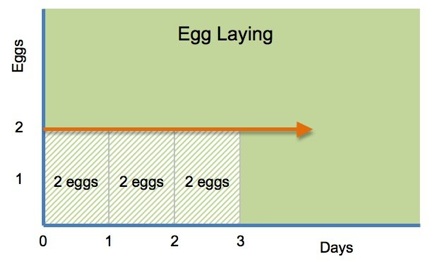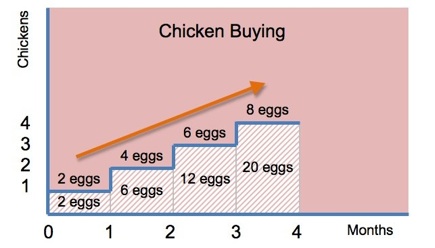What Are Differential Equations

-
1.A Simple Equation
An equation is a way of describing how one quantity relates to another. In its simplest form this might look like:
n = a + b
I have a friend Mr Smith. He has a large family so each week he buys a tray of eggs. Each tray carries eight boxes of six eggs. The equation for the total number of eggs is:
n = a x b
Substituting we have:
n = 8 x 6 So n = 48 eggs.
Simple Equations
This page follows the Differential Analysers page. Here I will compare simple equations with differential equations using worked examples.
3. How Rates Are Described
Let’s continue our example. Mr Smith’s wife buys a chicken and with TLC it is found to lay two eggs per day. The total number of eggs that she has is not a constant as it obviously increases every day. So the second quantity is ‘dependent’ on another and that is, as so often, time. The equation for the total number of her eggs is written as a Differential Equation:
n = a δt * eggs
So how many eggs will Mrs Smith have after three days ? On day 1 she gets two eggs, on day 2 she gets two eggs and on day 3 she gets two eggs. This process is called Integration and is best imagined as a graph. The graph would show a simple horizontal straight line (and so is called a First Order Equation). The total number of eggs is increasing and is given by the area under the graph.
The total number of eggs is:
2 x 3 = 6 eggs.



Differential Equations
2. What Does Differential Mean
A differential equation describes that something is different depending on the rate of change of something else. We are very familiar with rates of change that are dependent on time. We grow old slowly. The weeds in our garden grow too quickly ! The bus speeds us to the shops. The paint slowly flakes off our window frames. House prices are always going up. The shares on the stock exchange go up and down. Everything in nature has a rate be it positive or negative.
* Why Is The Equation Written With A δ Symbol?
The δ is the Greek letter delta. Greek is chosen to distinguish it from other letters that might be real quantities like a and b that we used above. Obviously d stands for difference and reminds us that there is a change in quantity going on. It could be the upper case delta Δ but ours is only a small change compared to the whole so the lower case letter is more appropriate. Also in Western science units named after a person are given in capitals eg Watt is names after James Watt, and ordinary units are in lower case like m stands for metre which isn’t anybody’s name.
So we have seen that the way to solve a Differential Equation is by integrating. Finally a sensible question to ask would be how long would it take Mrs Smith’s chicken to lay enough eggs for her family ? What we are searching for is the change in time that must elapse. We know that:
n = a.δt
by dividing both sides of the equation by δt we see that:
δt = n/a
By inserting for Mrs Smith’s quantities we see:
δt = 48/2 = 24 days.
I think Mrs Smith is going to have to buy some more chickens !
Uses Of Differential Equations
Rates Of Change Of Rates Of Change
This may sound alien to you. However Mrs Smith can’t afford to buy a whole lot of chickens all at once. However the clever lady decides to set aside the savings she’s making and buy one more chicken per month. The obvious question is: How soon will they become self-sufficient ?
Again let’s turn to a graph. This time the vertical axis shows how many chickens Mrs Smith has. You see that it’s no longer a horizontal straight line but the rate of production of eggs is increasing. Each month, as long as she talks to her chickens nicely, she gets more eggs.
Can you see that the total number of eggs she now has gathered altogether, shown by the area under the graph, is not increasing linearly. Quite quickly she has got 20 eggs ! This is called a Second Order Equation and is written.
n = a δt²
It shows us that there is a power law involved. I’m not going to solve it by blinding you with mathematics but this example shows that second, third even fourth order equations are quite normal in nature but they got ever harder to solve until Newton plied his hands to formalising the equations and those clever people screwed their nuts and bolts together and made the mechanical computer, the jolly old Differential Analyser which you were so keenly reading about.

Now return to the page: << Differential Analysers

Disclaimer
Whilst some care has been taken to check externally linked websites no responsibility is offered nor implied for the suitability, legality or reliability of content therein.